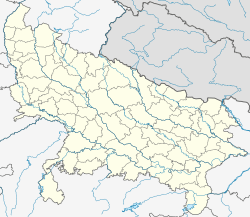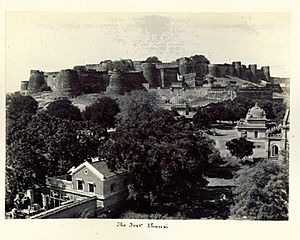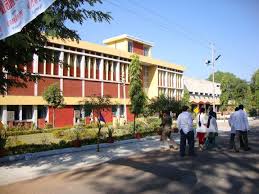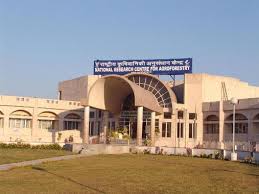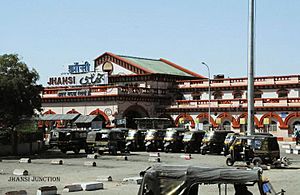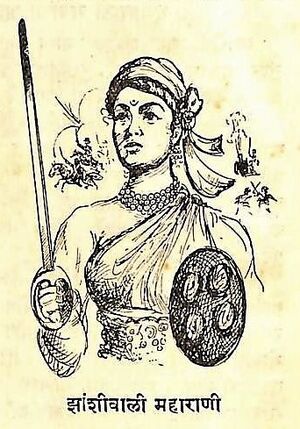Jhansi facts for kids
Quick facts for kids
Jhansi
|
|
|---|---|
|
Night view of Jhansi, Jhansi fort, Virangana Lakshmibai Railway Station, Statue of Jhalkaribai
|
|
Nickname(s):
|
|
| Country | |
| State | Uttar Pradesh |
| Region | Bundelkhand |
| District | Jhansi |
| Founded by | Raja of Orchha |
| Area | |
| • Metropolis | 160 km2 (60 sq mi) |
| Elevation | 285 m (935 ft) |
| Population
(2011 census)
|
|
| • Metropolis | 505,693 |
| • Rank | 57 |
| • Density | 3,160/km2 (8,190/sq mi) |
| • Metro | 547,638 |
| Language | |
| • Official | Hindi |
| • Additional official | Urdu |
| Time zone | UTC+5:30 (IST) |
| PIN |
284001-2-3-4
|
| Telephone code | 0510 |
| Vehicle registration | UP-93 |
| Sex ratio | ♂ 0.905 : ♀ 1.000 |
| Crude literacy | 73.90% |
| Effective literacy | 83.0% |
| Avg. summer temperature | 42.4 °C (108.3 °F) |
| Avg. winter temperature | 4.0 °C (39.2 °F) |
Jhansi is a historic city in the Indian state of Uttar Pradesh. Its old name was Balwant Nagar. The city is located in the Bundelkhand region, near the Pahuj River. Jhansi is the main administrative center for Jhansi district and Jhansi division.
People often call Jhansi the Gateway to Bundelkhand. It sits at an average height of 285 meters (935 feet). Jhansi is about 420 kilometers (260 miles) from New Delhi, India's capital. It is also about 315 kilometers (196 miles) from Lucknow, the state capital.
Jhansi has good connections to other major towns in Uttar Pradesh. It has strong road and railway networks. The city is also becoming a defense corridor. This will help its economy grow. Jhansi was named the third cleanest city in Uttar Pradesh in 2018. It was also the fastest-moving city in the North Zone. There are plans to build a new airport here. In 2011, Jhansi was chosen for India's Smart Cities Mission.
Contents
Understanding the Name of Jhansi
The name Jhansi might mean "covered in bushes." This comes from a Hindi word for "bushes" or "undergrowth."
There's also a fun old story about the name. A raja from Jaitpur was visiting the palace in Orchha. He was asked if he could see the fort at Jhansi from the rooftop. He supposedly said it looked "like a shadow" or "rather indistinct." This story is likely just a legend.
A Look at Jhansi's Past
Early Days: Orchha and Mughal Rule
Before the Jhansi Fort was built in 1613, the area was a forest. The land belonged to the nearby village of Lahargird. This village was part of the Orchha raja's territory.
Two herders are said to have built huts there around 1553. Later, Raja Vir Singh Deo of Orchha built the fort in 1613. A village then grew around it. It was first called Balwantnagar. We don't know when it became known as Jhansi.
After the death of Jhujhar Singh, Orchha's ruler, Jhansi came under Mughal control. Mughal soldiers and governors stayed here until the early 1700s.
Maratha Control
In 1722, Chhatrasal took over the Jhansi region. This was part of his new kingdom of Bundelkhand. But in 1728, Muhammad Khan Bangash drove him out. Jhansi then returned to Mughal control.
Chhatrasal asked for help from Baji Rao I, a leader of the Maratha Empire. Their combined armies defeated the Mughals. In return, Chhatrasal gave Jhansi to Baji Rao in 1731.
In 1742, Naru Shankar became the Maratha governor of Jhansi. During his time, Jhansi grew from a small village to a large town. He built new parts of the fort. He also brought people from other towns, like Orchha, to live in Jhansi.
Other governors followed Naru Shankar. In 1761, Ganesh Shambhaji, a Maratha officer, switched sides. He joined Shuja-ud-Daula, the Nawab of Awadh. Shuja-ud-Daula's forces captured Jhansi in 1762.
Mughal rule in Jhansi lasted only four years. Malhar Rao Holkar recaptured it for the Marathas. Naru Shankar was likely re-appointed governor.
The Newalkar Dynasty
The next important governor was Raghunath Rao Newalkar. He ruled until 1794. By then, he was almost independent. His brother, Sheo Rao Hari, took over. Sheo Rao built the city walls between 1796 and 1814.
Sheo Rao's family continued to rule Jhansi State until 1853. In 1804, Sheo Rao signed a treaty with the British. This created a military alliance. But Jhansi was still a Maratha vassal. In 1817, the British took over as the main power.
The last ruler of Jhansi State was Gangadhar Rao. He ruled from 1842 to 1853. He was a good leader and loved the arts. His only son died young. So, he and his wife, Lakshmi Bai, adopted a boy named Damodar Rao of Jhansi. This was allowed by Hindu law.
However, the British did not accept Damodar Rao as the next ruler. They used a rule called the Doctrine of Lapse. This rule meant that if a ruler died without a natural heir, their state would become British territory. So, in 1854, the British took control of Jhansi. Lakshmi Bai tried to appeal, but it didn't work.
In 1854, a British officer named Francis Gordon wrote about Jhansi. He estimated its population was 40,000 people. It was not a factory town. But it had a huge amount of trade. Goods worth millions of rupees passed through Jhansi each year.
The Rebellion of 1857
Many things made people unhappy in Jhansi before the rebellion. The British taking over Jhansi State was one reason. Other local leaders were also upset. They felt the British were taking away their power. People were also angry because the British allowed cow slaughter. This had been banned before. The British also stopped giving money to the Mahalakshmi temple.
The British army in Jhansi was made up of Indian soldiers. They had British officers.
Tensions exploded on June 5. Indian soldiers and artillery surrounded the fort. They said they would guard it themselves. Most British civilians hid in the main fort. The next day, more Indian soldiers joined the rebellion. They attacked and killed the British officers. The rebels then surrounded the main fort. On June 7, the British surrendered. They were marched outside the city walls and executed.
Rani Lakshmi Bai's Leadership
On June 9, Lakshmi Bai and a relative, Sada Sheo Rao, argued over who would rule. Lakshmi Bai offered more to the rebels. So, they gave her control of Jhansi. A public announcement was made. It said, "The people are God's, the country is the Padishah's, and the raj is Rani Lakshmi Bai's."
Lakshmi Bai quickly set up her government. She started a mint to make coins. She also raised an army. She made the forts at Jhansi and Karahra stronger. She tried to stay friendly with the British. She wrote to a British agent, Major Erskine. She said she only helped the rebels because she was forced to. She denied the massacre of British prisoners. She presented herself as a caretaker ruler. Erskine told her to rule for the British until their troops arrived. He promised she would be treated well.
The main people in her government were her father, Moropant Tambe, and other important officials.
Meanwhile, the raja of Orchha invaded Jhansi. He hoped to get back lands his family had lost. He told the British he was helping them fight the "rebellious rani." His troops looted the countryside. They besieged Jhansi on September 3. He lifted the siege on October 22. This happened when more troops came to help Jhansi. In early 1858, Lakshmi Bai drove the Orchha troops out. She had full control of Jhansi State again.
Even in February 1858, Lakshmi Bai promised loyalty to the British. She sent letters saying she would give up Jhansi if treated honorably. But the British governor-general, Charles Canning, did not trust her. He saw her as a rebel. On February 11, Canning ordered her to be tried if captured.
Lakshmi Bai decided she could not trust the British. Her only choice was to fight. On February 14, she told Hindus and Muslims to fight the British. She said they would "destroy the people's religion." She had 12,000 soldiers and many cannons. She also talked with other rebel leaders, like Tantya Tope.
The British Attack and Capture
Lakshmi Bai's commanders burned all the plants outside the fort. This was to stop British troops from finding food. But the rajas of Orchha and Gwalior gave plenty of supplies to the British.
British forces, led by Hugh Rose, arrived on March 21. They began a siege the next day. On April 1, about 22,000 troops under Tantya Tope came to help Jhansi. They fought the British at Basoba. Tantya Tope's forces attacked both sides of the British army. But the British cavalry used the same tactic. They surrounded Tantya's forces, who then fled.
On April 3, the British stormed the city. They entered through a broken part of the wall. For two days, there was fierce fighting in the streets. The British tried to reach the fort. On the night of April 4-5, Lakshmi Bai escaped. She left with her bodyguards and followers. They headed towards Kalpi. The British took the fort the next day.
Rose's troops looted Jhansi. They took jewelry and other valuables. They also destroyed many houses and temples. The royal family's collection of Sanskrit writings was lost. However, Rose told the governor-general that his troops had acted peacefully.
British Rule in India
After the rebellion, the British rebuilt their army camp in Jhansi. It was south of the city walls. In 1861, the town and fort of Jhansi were given to Gwalior State. But Jhansi was returned to British rule in 1885. This was in exchange for Gwalior, which the British had taken.
The railway came to Jhansi in 1889. This was when the Indian Midland Railway was finished. Jhansi became the railway's main office. It was also an important junction. Lines went to Kanpur and Agra. The railway quickly brought a lot of trade to Jhansi. Jhansi became a very important business center. It became more important than Mau-Ranipur.
In 1899, the Hardiganj market opened. It became the biggest market in the city. It supplied goods to all other markets.
The Indian National Congress came to Jhansi in 1886. In 1888, Sripavati Ghosh was chosen to represent Jhansi. The Congress held its provincial meeting in Jhansi in 1916.
From 1926, the revolutionary Chandra Shekhar Azad lived in Jhansi. He pretended to be a driver or a mechanic.
Independent India
After India became independent, Jhansi became part of Uttar Pradesh state.
Geography and Weather
Jhansi is located at 25.4333 N and 78.5833 E. It is about 284 meters (935 feet) above sea level. Jhansi is on a rocky plateau in central India. The land slopes down to the north. This is because it's on the edge of the large plains of Uttar Pradesh. The land rises to the south.
The soil is good for citrus fruits. Crops like wheat, pulses, peas, and oilseeds grow here. The region depends a lot on monsoon rains for watering crops. A big canal project, the Rajghat canal, is building canals for irrigation. This will help Jhansi, Lalitpur, and parts of Madhya Pradesh. Trading farm products is very important for the economy. Jhansi is also known for making brassware.
Jhansi's Climate
Jhansi is on a rocky plateau, so it has very hot summers and cool winters. Winter starts in October. Temperatures can be as low as 4°C (39°F) and as high as 21°C (70°F). Spring is short and comes in late February.
Summer begins in April. Temperatures can reach 47°C (117°F) in May. The rainy season starts in late June. Monsoon rains bring most of the yearly rainfall. In the rainy season, the average daily high is around 36°C (97°F). It is also very humid. The city gets about 1150 mm (45 inches) of rain each year. This mostly happens during the monsoon.
In summer, temperatures can go from 45°C to 49°C (113°F to 120°F). In winter, temperatures can drop to 0°C to 1°C (32°F to 34°F).
| Climate data for Jhansi (1981–2010, extremes 1901–present) | |||||||||||||
|---|---|---|---|---|---|---|---|---|---|---|---|---|---|
| Month | Jan | Feb | Mar | Apr | May | Jun | Jul | Aug | Sep | Oct | Nov | Dec | Year |
| Record high °C (°F) | 33.8 (92.8) |
39.4 (102.9) |
43.3 (109.9) |
46.2 (115.2) |
49.3 (120.7) |
47.8 (118.0) |
45.6 (114.1) |
42.2 (108.0) |
40.6 (105.1) |
40.6 (105.1) |
38.1 (100.6) |
33.1 (91.6) |
49.3 (120.7) |
| Mean daily maximum °C (°F) | 23.4 (74.1) |
27.5 (81.5) |
34.0 (93.2) |
39.6 (103.3) |
42.4 (108.3) |
40.5 (104.9) |
34.4 (93.9) |
32.5 (90.5) |
33.5 (92.3) |
34.1 (93.4) |
30.0 (86.0) |
25.4 (77.7) |
33.1 (91.6) |
| Mean daily minimum °C (°F) | 8.1 (46.6) |
11.1 (52.0) |
16.7 (62.1) |
22.6 (72.7) |
26.7 (80.1) |
27.5 (81.5) |
25.1 (77.2) |
23.9 (75.0) |
23.2 (73.8) |
19.5 (67.1) |
13.8 (56.8) |
9.5 (49.1) |
19.0 (66.2) |
| Record low °C (°F) | 1.2 (34.2) |
0.6 (33.1) |
5.3 (41.5) |
10.1 (50.2) |
15.1 (59.2) |
18.5 (65.3) |
20.3 (68.5) |
18.3 (64.9) |
16.7 (62.1) |
10.7 (51.3) |
1.1 (34.0) |
0.3 (32.5) |
0.3 (32.5) |
| Average rainfall mm (inches) | 8.5 (0.33) |
9.2 (0.36) |
10.0 (0.39) |
2.6 (0.10) |
15.5 (0.61) |
92.3 (3.63) |
238.9 (9.41) |
263.1 (10.36) |
168.3 (6.63) |
28.4 (1.12) |
5.3 (0.21) |
3.6 (0.14) |
845.6 (33.29) |
| Average rainy days | 0.8 | 1.0 | 0.8 | 0.5 | 1.7 | 5.0 | 11.4 | 12.6 | 6.9 | 1.4 | 0.5 | 0.4 | 43.0 |
| Average relative humidity (%) (at 17:30 IST) | 51 | 40 | 27 | 22 | 24 | 39 | 66 | 73 | 62 | 43 | 44 | 52 | 45 |
| Source: India Meteorological Department | |||||||||||||
Jhansi was ranked as the 3rd best "National Clean Air City" in 2024. This was for cities with 3-10 lakh people.
People and Languages
| Historical population | ||
|---|---|---|
| Year | Pop. | ±% |
| 1871 | 30,000 | — |
| 1881 | 33,000 | +10.0% |
| 1891 | 53,779 | +63.0% |
| 1901 | 55,724 | +3.6% |
| 1911 | 70,200 | +26.0% |
| 1921 | 66,400 | −5.4% |
| 1931 | 76,700 | +15.5% |
| 1941 | 103,300 | +34.7% |
| 1951 | 127,400 | +23.3% |
| 1961 | 140,200 | +10.0% |
| 1971 | 173,300 | +23.6% |
| 1981 | 231,300 | +33.5% |
| 1991 | 300,850 | +30.1% |
| 2001 | 426,198 | +41.7% |
| 2011 | 505,693 | +18.7% |
| Source: 1871-1891 - The Imperial Gazetteer of India 1901-1981 - Populstat.info 1991-2011 - Citypopulation.de |
||
| Religions in Jhansi city (2011) | ||||
|---|---|---|---|---|
| Religion | Percent | |||
| Hinduism | 81.10% | |||
| Islam | 16.51% | |||
| Christianity | 0.94% | |||
| Sikhism | 0.52% | |||
| Jainism | 0.46% | |||
| Other or not stated | 0.47% | |||
| Distribution of religions | ||||
In 2011, Jhansi city had a population of 505,693 people. There were more males (265,449) than females (240,244). About 55,824 children were aged 0 to 6 years.
Most people in Jhansi city can read and write. About 73.9% of the population is literate. This means 78.9% of males and 68.3% of females are literate. For people aged 7 and above, the literacy rate is even higher, at 83.0%.
Hindi is the main language spoken in Jhansi. A smaller number of people speak Urdu.
The larger Jhansi urban area, which includes Jhansi Cantonment and Jhansi Railway Settlement, had a population of 547,638.
Jhansi Cantonment
In 2011, Jhansi Cantonment had 28,343 people. Most people here are literate, with 82.4% able to read and write.
Jhansi Railway Settlement
Jhansi Railway Settlement had 13,602 people in 2011. About 79.1% of its population is literate.
Songs and Poems about Jhansi
Many patriotic songs have been written about Rani Lakshmibai. The most famous one is the Hindi poem Jhansi ki Rani. It was written by Subhadra Kumari Chauhan. This poem describes Rani Lakshmibai's life with strong emotions. It is often taught in Indian schools.
A popular part of the poem says:
बुंदेले हरबोलों के मुँह हमने सुनी कहानी थी,
खूब लड़ी मर्दानी वह तो झाँसी वाली रानी थी।।
This means: "From the bards of Bundela, we heard this story / She fought bravely like a warrior woman, she was the queen of Jhansi."
Marathi people also have a well-known song about the queen. It was written by B. R. Tambe. He was a famous poet from Maharashtra.
Learning and Education
Higher Education Institutions
Jhansi has several places for higher education:
- Bundelkhand University
- Rani Lakshmi Bai Central Agricultural University
- Central Ayurveda Research Institute
Medical and Technical Colleges
In 2009, the government approved building a new medical institute. It is similar to AIIMS. This was the first such institute in the Bundelkhand region.
- Bundelkhand Institute of Engineering & Technology
- Government Polytechnic Jhansi
- Maharani Laxmi Bai Medical College, started in 1968
- Maharani Laxmi Bai Para medical Training College
Schools in Jhansi
Jhansi has many schools, including:
- Christ the King College, Jhansi
- Army Public School, Jhansi
- Blue Bells Public School, Jhansi
- Cathedral College, Jhansi
- Delhi Public School, Jhansi
- Kendriya Vidyalaya, Jhansi
- Rani Laxmibai Public School, Jhansi
- Sainik School, Jhansi
- St. Francis Convent School, Jhansi
Getting Around Jhansi
The city is well-connected to other parts of India. It has good railway and highway networks.
Train Travel
Jhansi has its own railway division. It is part of the North Central Railway. The city is on the main train lines from Delhi to Chennai and Delhi to Mumbai. The station code is VGLJ. Trains to all parts of India are available all day. The first ever Shatabdi Express started its journey from New Delhi to Jhansi Jn. Every train stops at Jhansi Jn.
Road Travel
Jhansi is where several important national highways meet. These include National Highway 27 (India) (Gujarat to Assam) and National Highway 44 (India) (Jammu to Kanyakumari). This makes Jhansi a key point in India's road network. Highways go in five different directions from the city.
You can reach many towns and cities from Jhansi by road. These include Gwalior, Agra, New Delhi, Bhopal, and Lucknow.
Air Travel
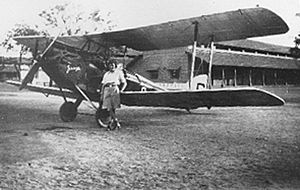
The Jhansi Airstrip is a military air base. It was built during British rule. The Indian army uses it, and political leaders visit by air. Private planes can land there. However, there are no regular passenger flights.
There have been requests to open it for commercial flights. In 2011, the Uttar Pradesh government announced plans for a new civil airport. This would help tourism in Bundelkhand. As of 2020, Gwalior Airport is the closest airport with direct flights to major cities. It is about 102 km (63 miles) from Jhansi.
Military Presence
The Jhansi Cantonment was where British military and civilian staff lived. Today, Jhansi district is the main base for the 31st Indian Armoured Division. This division is stationed at Jhansi-Babina. In 2012, there was a joint military exercise here. The Singaporean Army joined the Indian Army. The President of India, Pratibha Patil, watched this exercise.
News and Media
Amar Ujala, Dainik Jagran, Patrika, and Dainik Bhaskar are some newspapers with online news.
Newspapers in Jhansi
Many newspapers are published in Jhansi. They are in Hindi, Urdu, and English.
| Newspaper | Language |
|---|---|
| Janhit Darshan | Hindi |
| Darshan Post | Hindi |
| Amar Ujala | Hindi |
| Dainik Jagran | Hindi |
| Daily Aziz E Hindustan | Urdu |
| Dainik Royal Mail | Hindi |
| Dainik Vishwa Pariwar | Hindi |
| Hindustan | Hindi |
| Jan Jan Jagran | Hindi |
| Jan Seva Mail | Hindi |
| Raftaar | Hindi |
| Patrika | Hindi |
| Swadesh | Hindi |
| Dainik Uddhog Hakikat | Hindi |
| Look Media | Hindi |
Radio Stations
Jhansi has five radio stations:
- Radio Mirchi 98.3 FM
- 92.7 BIG FM
- 103.0 AIR FM
- 91.1 Red FM
- 93.5 FM
Sports in Jhansi
Jhansi has several sports stadiums. These include Dhyanchand Stadium, Railway Stadium, and LVM Sports Place. Dhyanchand Stadium is a great place to learn sports. Many sports are played there, like hockey, cricket, football, and chess.
Famous People from Jhansi
Many notable people have connections to Jhansi:
- Pradeep Jain Aditya, an Indian politician.
- Ramesh Chandra Agarwal, founder of the Dainik Bhaskar newspaper group.
- Chandra Shekhar Azad, an Indian freedom fighter.
- Major Dhyan Chand, a famous Indian field hockey player.
- Maithili Sharan Gupt, a modern Hindi poet.
- Jhalkaribai, a freedom fighter and advisor to Rani Lakshmi Bai.
- Rani of Jhansi, the queen of Jhansi (1853–58).
- Abdul Karim, an Indian attendant to Queen Victoria.
- B. B. Lal, a former head of the Archaeological Survey of India.
- Pankaj Mishra, an Indian writer.
- Joy Mukherjee, an Indian actor and director.
- Vrindavan Lal Verma, a Hindi novelist and playwright.
Images for kids
See also
 In Spanish: Jhansi para niños
In Spanish: Jhansi para niños






